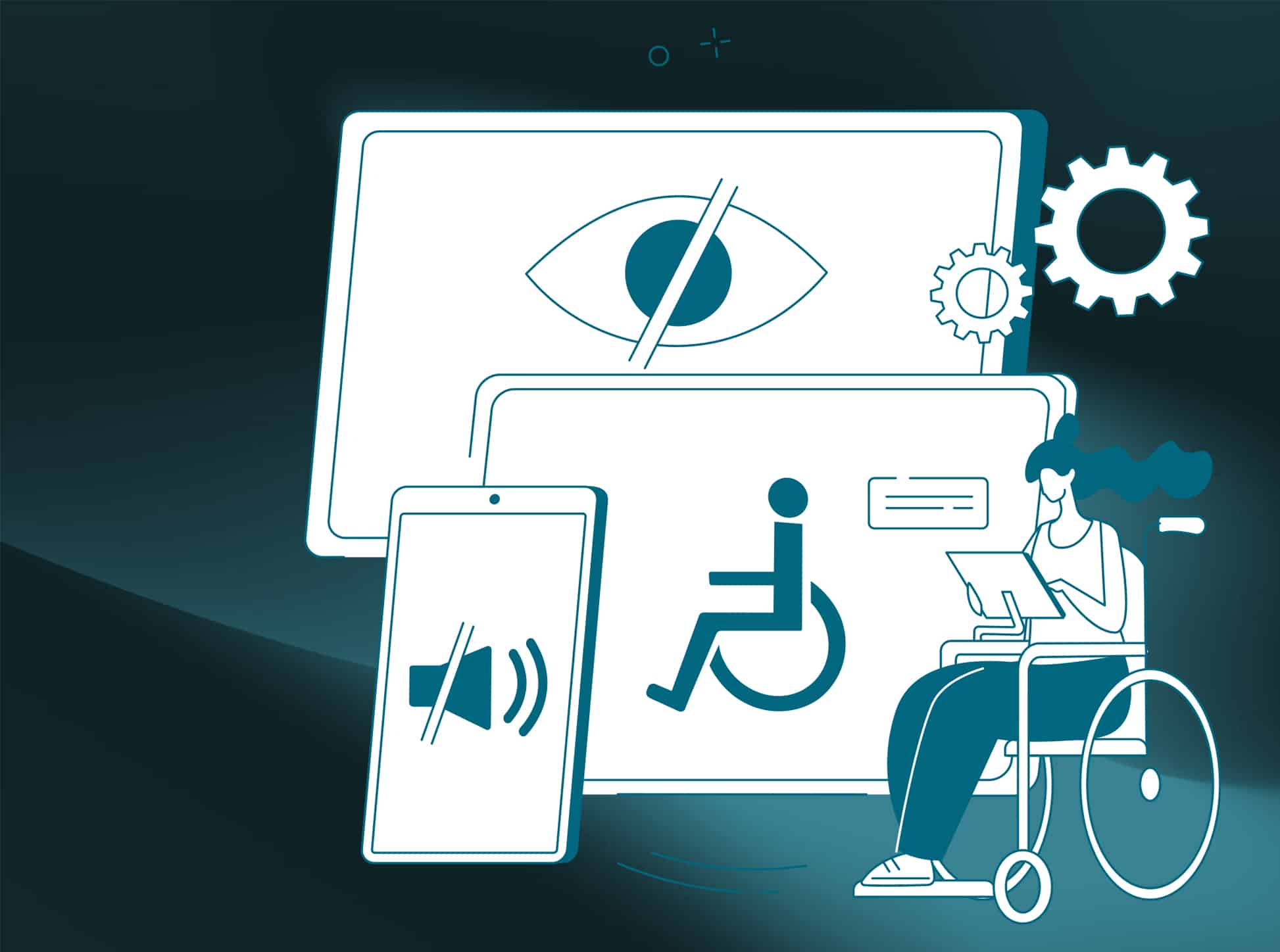Contact
Get in touch with us so that we can create a digital project after a free initial consultation and work out a roadmap together.
Learn More

The countdown is on: On June 28, 2025, the new Accessibility Strengthening Act (BFSG) will come into effect, requiring all websites, online shops, and other digital services to be accessible. This means that—if not already done—you’ll need to implement comprehensive technical adjustments to your online presence and apps. Learn more here about the BFSG and all the new technical requirements!
Digital accessibility means making your website usable for everyone—regardless of potential impairments such as visual, motor, or hearing disabilities. Everyone should be able to perceive, understand, and interact with digital content.
Key elements of accessibility include keyboard navigation (i.e., using the website without a mouse), screen reader compatibility, as well as audio descriptions and/or subtitles for videos. Content should also be available in plain language, and users should have the ability to adjust contrast and font sizes individually.
For technical implementation, website operators should follow international standards such as the Web Content Accessibility Guidelines (WCAG).

The Web Content Accessibility Guidelines (WCAG) define the four principles of accessibility, summarised under the acronym POUR:
Perceivable
One of the most important points defined by the WCAG is that all content on websites, mobile applications and software interfaces must be accessible to all the senses – not just visually.
To achieve this goal, you should provide text alternatives for images, videos and audio files. Sufficient contrast between text and background is also crucial for optimal perceptibility. It must also be possible to enlarge content without losing information or functions.
Operable
To ensure that all users can use the website without barriers, it should be fully keyboard accessible. The user guidance must be clearly structured so that the focus is visible at all times. In addition, the placement of flashing or flickering elements should be avoided in order to prevent health impairments such as seizures or nausea. Navigation should be consistent and predictable so that users can find their way around at all times.
Understandable
Your website should be designed according to this principle not only technically, but also in terms of content. Texts and functions must therefore be understandable and predictable. Simple language should be used and clear instructions given. Errors – for example in forms – should be clearly labelled and easy to correct.
Robust
In functional terms, the Web Content Accessibility Guidelines (WCAG) also require content to be compatible with current and future technologies. This includes correct HTML and CSS as well as semantically clean labelling. Assistive technologies must also be able to interpret the content reliably.
According to the Web Content Accessibility Guidelines, the degree of accessibility of your website can be categorised into different compliance levels: Level A fulfils the minimum requirements according to these, AA corresponds to the recommended standard and is often mandatory by law and AAA is defined as the highest level, which is usually fulfilled voluntarily – until now!
Starting in summer 2025—specifically on June 28—the Accessibility Strengthening Act (BFSG) will come into effect. It serves to implement EU Directive 2019/882 of the European Parliament and Council dated April 17, 2019.
The aim of the BFSG is to create a unified legal framework for accessible products and services within the EU internal market. The legal basis includes not only EU Directive 2019/882 and the BFSG as a federal law but also the corresponding Accessibility Strengthening Act Regulation (BFSGV). This framework is complemented by existing regulations such as the Equal Opportunities for Persons with Disabilities Act (BGG), the General Equal Treatment Act (AGG), and the Telecommunications Act (TKG).
The legislation clearly defines who must implement the requirements of the BFSG by the end of June 2025: Primarily, it applies to private companies that offer certain digital services, such as e-commerce, e-books, online banking, and passenger transport.
Online shops and websites with sales functions, as well as mobile apps, software, and hardware with digital interfaces, are also required to comply with the BFSG regulations.
From a technical perspective, the requirements of the international standard for accessible web content must be implemented—in line with the classification of the Web Content Accessibility Guidelines (WCAG), this corresponds to conformance level AA.
We’ve summarised these requirements for you here:
The legal and regulatory basis for this is not only the German Accessibility Improvement Act (BFSG), but also the German Product Safety Act (ProdSG) for accessible end devices and the European standard DIN EN 301 549 on digital accessibility. There are also documentation obligations, such as the declaration of accessibility and a feedback function.

You’re now informed but still have a lot of question marks when it comes to implementing the technical requirements for your own website? Then give us a call!
Our codafish team of web developers will support you in making your website accessible. We analyse your frontend and, most importantly, your content management system, create a customized project plan, and—if desired—handle all the necessary adjustments and developments on your website.
We provide comprehensive consulting, guide you step by step, and ensure you reach your goal safely: the 100% implementation of all requirements of the Accessibility Strengthening Act.
Yes, due to legal regulations, you may face penalties if you do not meet the requirements of the Accessibility Strengthening Act. The BFSG provides for fines of up to €100,000 and the public disclosure of violations. Additionally, warnings may be issued by associations or competitors.
Legal counsel is not mandatory for fulfilling all the requirements of the Accessibility Strengthening Act, but it is recommended—especially in complex cases or if you operate a large platform. You should also consult legal experts when drafting and reviewing a legally compliant accessibility statement. In general, an optimal combination of technical consulting and legal assessment is advisable for this topic.
In principle, you can build an accessible website with any CMS. However, when choosing your CMS, make sure it supports accessible themes and plugins. Content Management Systems like WordPress or Drupal already offer good foundations for this. You should also ensure the use of semantic markup and avoid relying heavily on JavaScript-only functions without alternatives.
The market surveillance authorities of the federal states are responsible for checking website accessibility, as detailed in the BFSGV. Federal agencies for accessible telecommunications services also review websites.
If users identify and report accessibility deficiencies on your website, the responsible supervisory authority will initiate a review.
